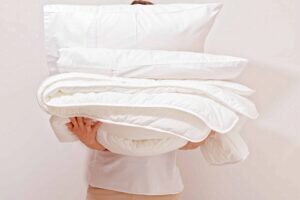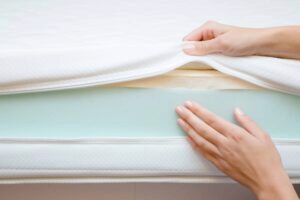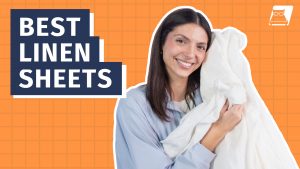Best Comforters
Disclosure: By clicking on the product links in this article, Mattress Nerd may receive a commission fee at no cost to you, the reader. Read full disclosure statement.
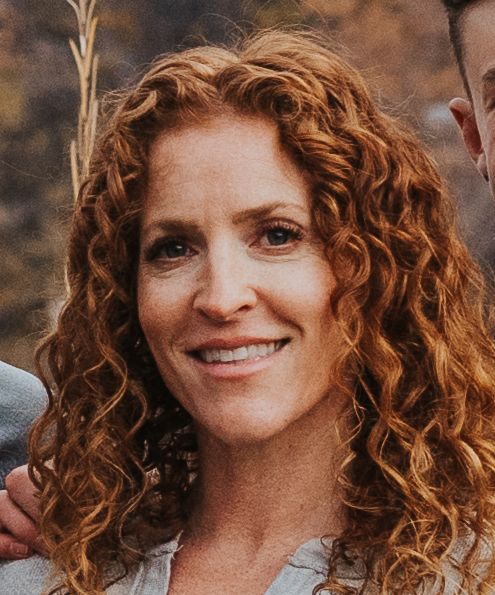
Written by Jessica Timmons, Contributor
Methodology
Our team of Certified Sleep Science Coaches have reviewed hundreds of mattresses and sleep products for over eight years using hands-on testing. We assess each sleep product for comfort, support, cooling, firmness, pressure relief, and more.
Learn more.
In This Article
We’ll share our our top choices for the best mattresses for side sleepers and considerations when looking for the best mattress for you. We recently updated this article with updated testing.
While great sheets get a lot of attention, it’s the comforter that can make or break your sleep experience. Fortunately, comforters come in a range of materials, sizes, weights and price points, which means there’s something for everyone—you just need to know how to look.
Our expert bedding testers compiled this list based on hand-on testing and personal experience. Their diverse preferences and opinions helped inform this list, so that the widest range of sleepers could be accommodated. Below, you’ll find our list for the best comforters, where everyone can find a great option for them!
Bottom Line: What’s the Best Comforter?
Our expert product testers chose the Brooklinen Down comforter as the Nerd’s Pick for the Best Comforter due to its choice of weights to suit a range of sleeper preferences, ethically sourced goose down, and excellent construction.
Best Comforters of 2025
- Brooklinen Down Comforter – Best All-Around
- Luxome ClimaSense Comforter – Best Cotton Comforter
- Saatva All-Year Down Alternative Comforter – Best Down Alternative
- Cozy Earth Silk Comforter – Best Luxury Comforter
- Coop Sleep Goods Exhale Comforter – Best Adjustable Comforter
- TEMPUR-Pedic Primaloft Comforter – Best Hypoallergenic Comforter
- Puffy Deluxe Comforter – Best Value Comforter
- Brooklinen Weighted Comforter – Best Weighted Comforter
- Layla Down Alternative Comforter – Best Cooling Comforter
Best Comforters: Video Review

Chosen by Experts and Advocates
To put together this list of the best comforters, our Certified Sleep Science Coaches performed hands-on testing to evaluate elements like temperature-regulation, materials, and overall comfort. Our team has different preferences, which help us make decisions when it comes to superlatives and overall recommendations. We bring the products into our testing lab to get a closer look at how they feel and look so that we can deliver the most realistic reviews possible.
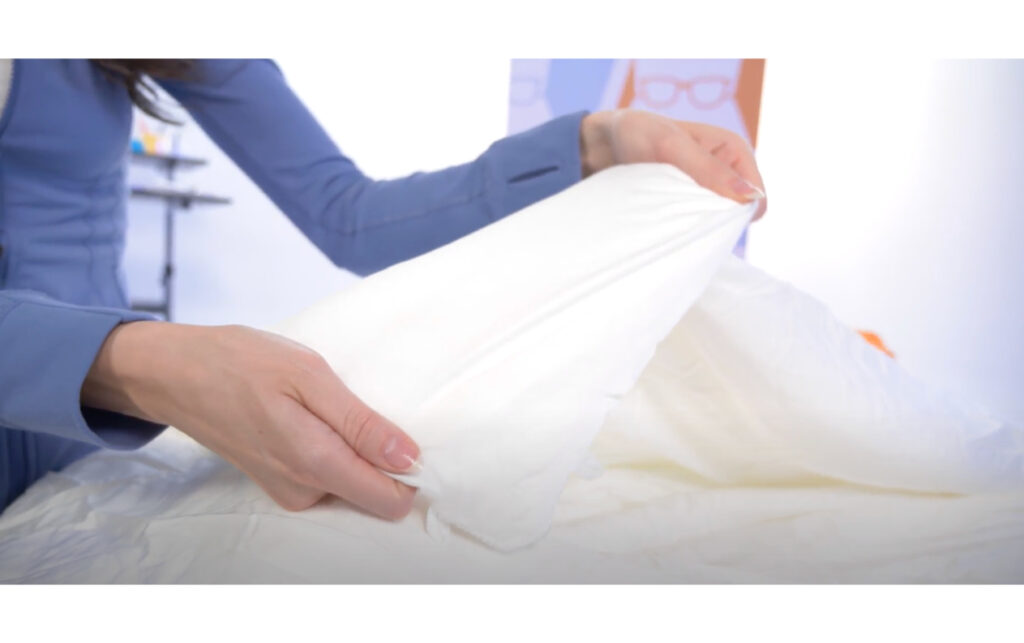
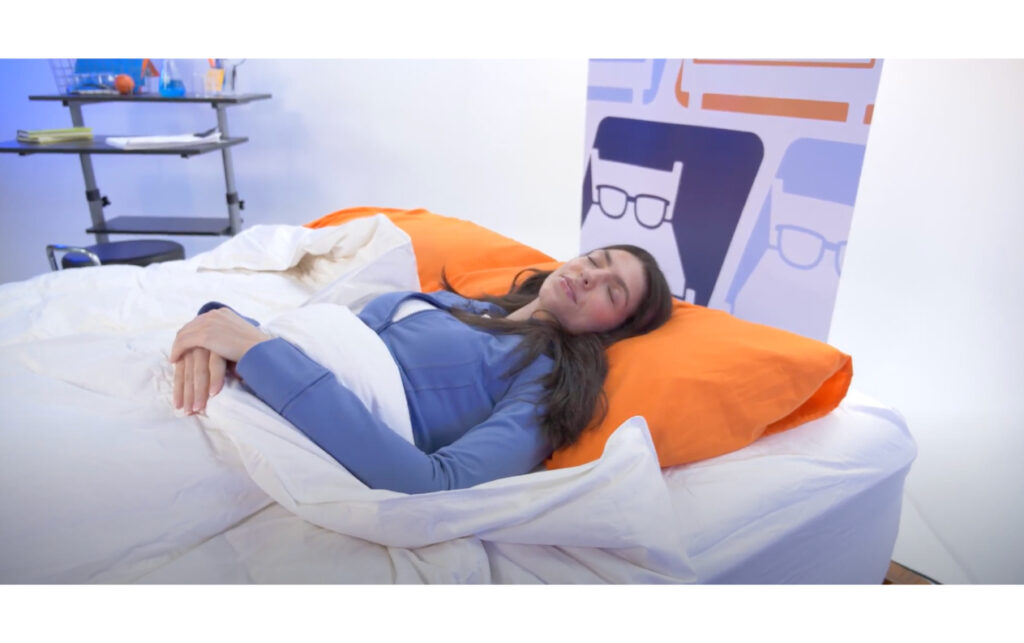
Nerd’s Pick: Brooklinen Down Comforter
Brooklinen Down Comforter
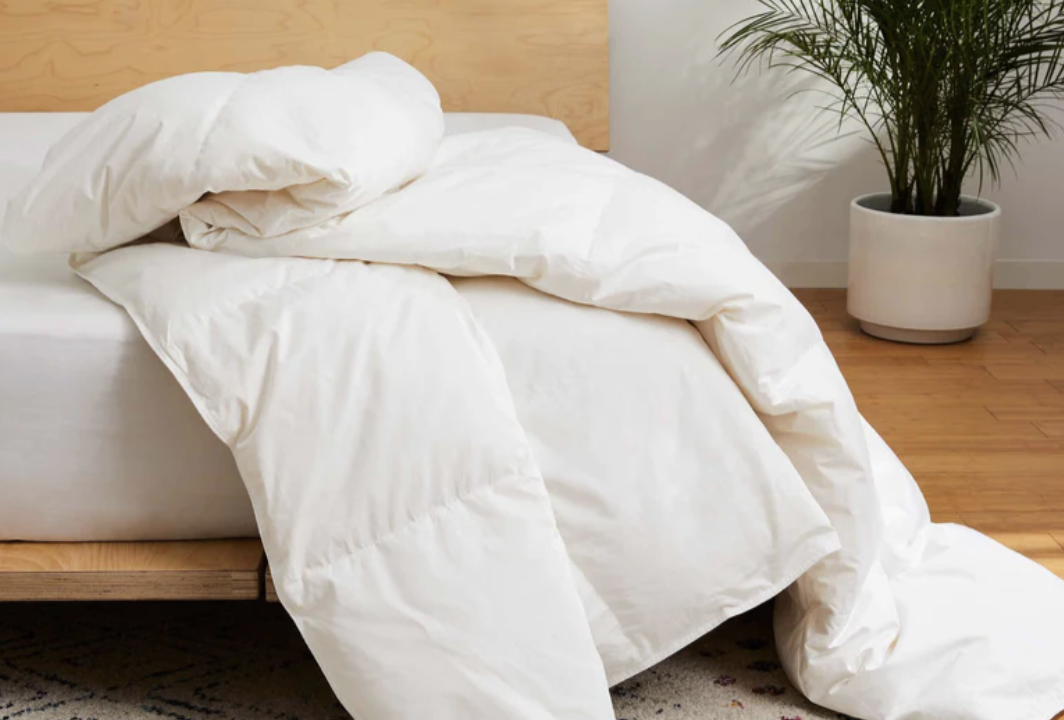
This Down comforter from Brooklinen is an affordable and high quality option for your bedding. Choose between three weights that correspond with your temperature preferences and environment.
Mattress Nerd Score
4.70 / 5
Accessories Details
Material
Cotton, Down
Trial Period
365 nights
Warranty
2-year warranty
Financing
Available
Shipping Method
Free shipping
Return Policy
Free returns
Brooklinen’s classic down comforter is the airy, cozy comforter of your dreams. Sold in a choice of weights for the precise level of warmth, each comforter is made with 100 percent down cluster fill with a soft cotton shell.
How We Select Nerd’s Pick
We select our Nerd’s Pick by considering the option that’ll accommodate the most amount of people. As for the best comforter, we wanted one that would work for hot and cold sleepers, those with allergies, and would be reasonably priced. We selected the Brooklinen Down comforter because it checked all of the boxes!
What our testers say: “The Brooklinen Down comforter is great for those who want options along their buying journey. The fact you can choose the weight and fill according to your climate offers a personalized product that will keep you cozy all night.” – Loren, Editor & Bedding Tester
Best Cotton Comforter: Luxome ClimaSense Comforter
LUXOME ClimaSense Comforter
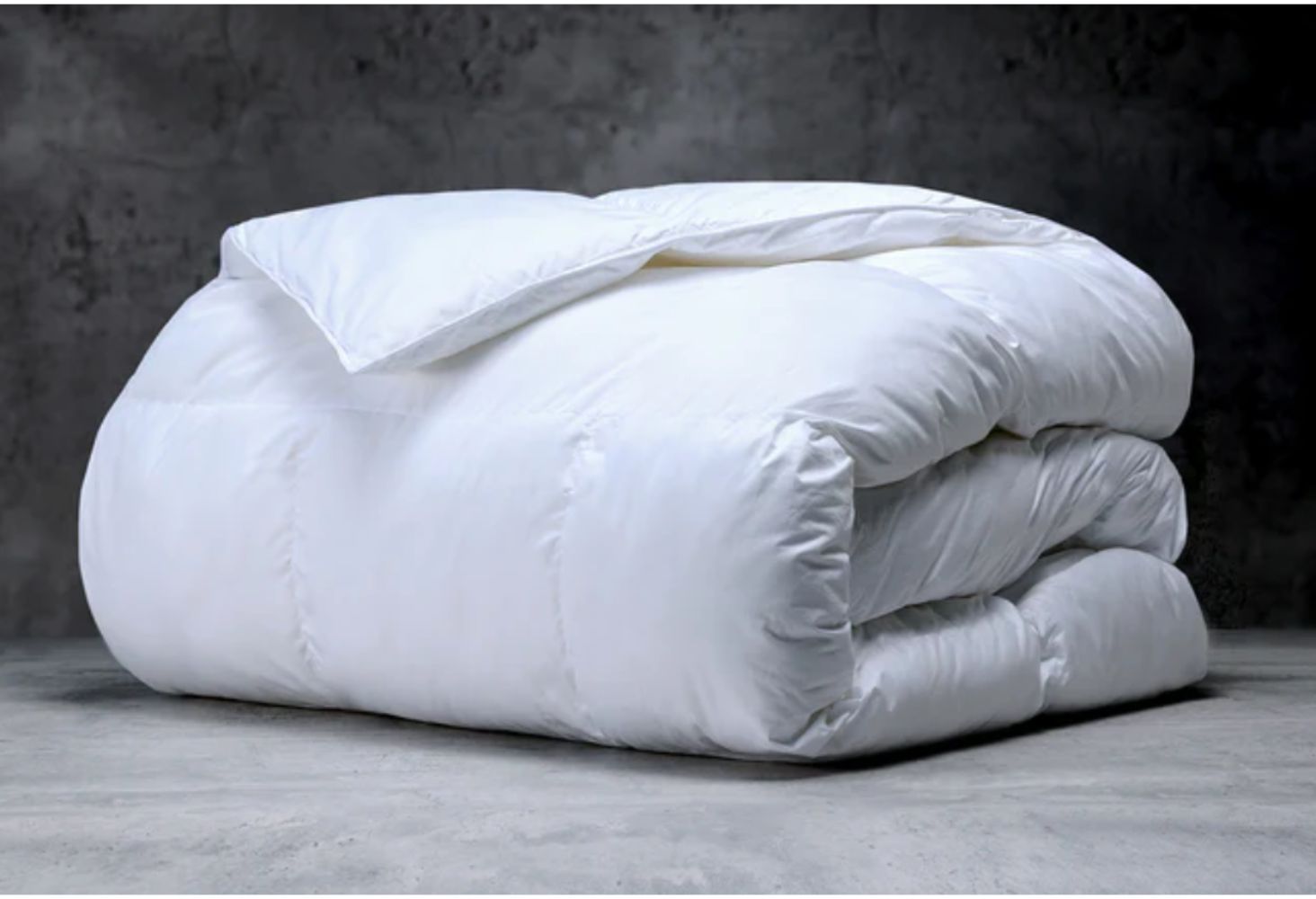
The LUXOME ClimaSense uses special cooling technology to adjust to your body temperature to keep you comfortable all night long.
Mattress Nerd Score
5.00 / 5
Accessories Details
Material
Cotton, Polyester
Trial Period
30 nights
Financing
Not Available
Shipping Method
Free shipping
The ClimaSense Comforter is made with polyester infused with Luxome’s trademarked 37.5 Technology, which uses volcanic minerals to help ensure temperature regulation while you sleep. It’s an ultra-luxurious, ultra-breathable comforter with a baffle-box design that mimics the fluffiness of down without the extra warmth.
What our testers say: “When I tested it, I immediately felt a cool to the touch sensation and overall plushness. It did feel slightly heavy, kind of like a weighted blanket sensation, but I didn’t feel any heat retention.” – Becca, Editor & Lead Bedding Tester
Best Down Alternative: Saatva All-Year Down Alternative Comforter
Saatva All-Year Down Alternative Comforter
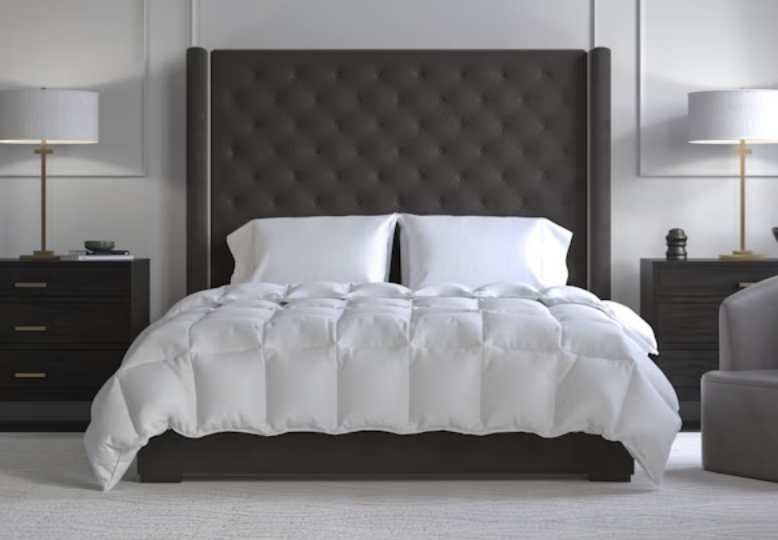
The Saatva All-Year Down Alternative Comforter is perfect for those who want the feel of down without the animal product.
Mattress Nerd Score
5.00 / 5
Accessories Details
Material
Cotton, Down Alternative, Lyocell
Trial Period
45 nights
Warranty
1-year limited warranty
Financing
Not Available
Shipping Method
Free shipping
Return Policy
Free returns
Saatva’s plush and airy comforter is an excellent dupe for the cozy feel of real down—minus the feathers. Instead, it’s made with a blend of down alternative fiber and lyocell, a sustainable fiber that is naturally moisture-wicking. It makes for a hypoallergenic comforter that’s designed for year-round use. Plus, it’s machine washable and has a 45-day return window.
What our testers say: “When I tried it for myself, it felt crisp, yet cozy. As someone who starts off the night cold and tends to heat up mid sleep, this comforter stayed on me without overheating and felt great to cozy into.” – Becca, Editor & Lead Bedding Tester
Best Luxury Comforter: Cozy Earth Silk Comforter
Cozy Earth Silk Comforter
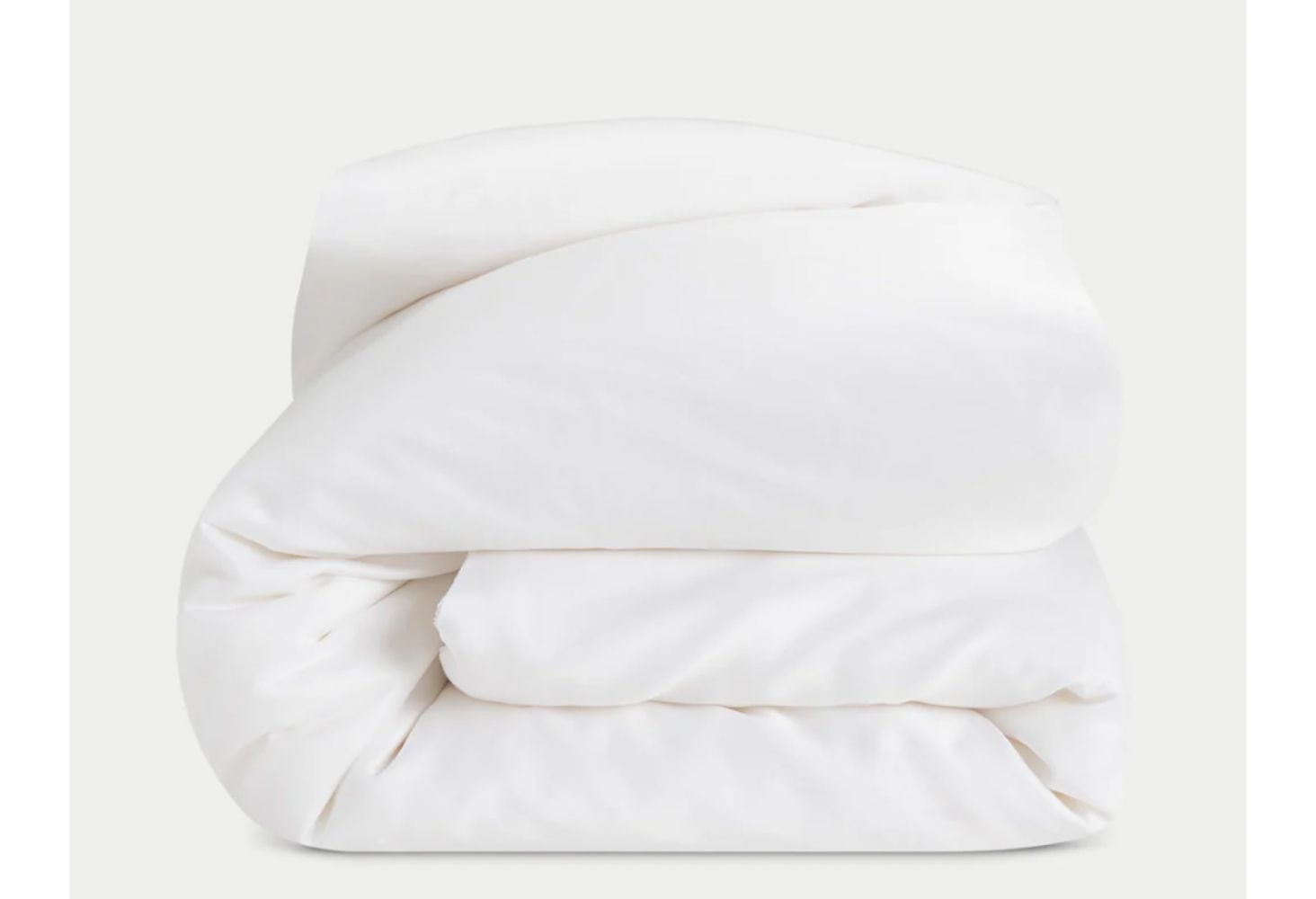
If you’re looking for a luxurious upgrade to your bedding, the Cozy Earth Silk comforter is the perfect fit— featuring 100% Mulberry silk and bamboo viscose.
Mattress Nerd Score
5.00 / 5
Accessories Details
Material
Bamboo, Silk
Trial Period
100 nights
Warranty
10-year warranty
Financing
Not Available
Shipping Method
Free shipping
Return Policy
Free returns
The Cozy Earth Silk Comforter could be a dream come true. It’s made with 100 percent mulberry silk for a luxuriously plush feel and a warm weight. It’s available in two fill options. Both standard and extra fill weights are good choices for sleepers who like a warm, cozy comforter.
What our testers say: “This is a great option to have in the fall/winter months. But caution, you probably won’t want to leave your bed.” – Becca, Editor & Lead Bedding Tester
Best Adjustable Comforter: Coop Sleep Goods Exhale All-Season Adjustable Comforter
Coop Sleep Goods Exhale All-Season Adjustable
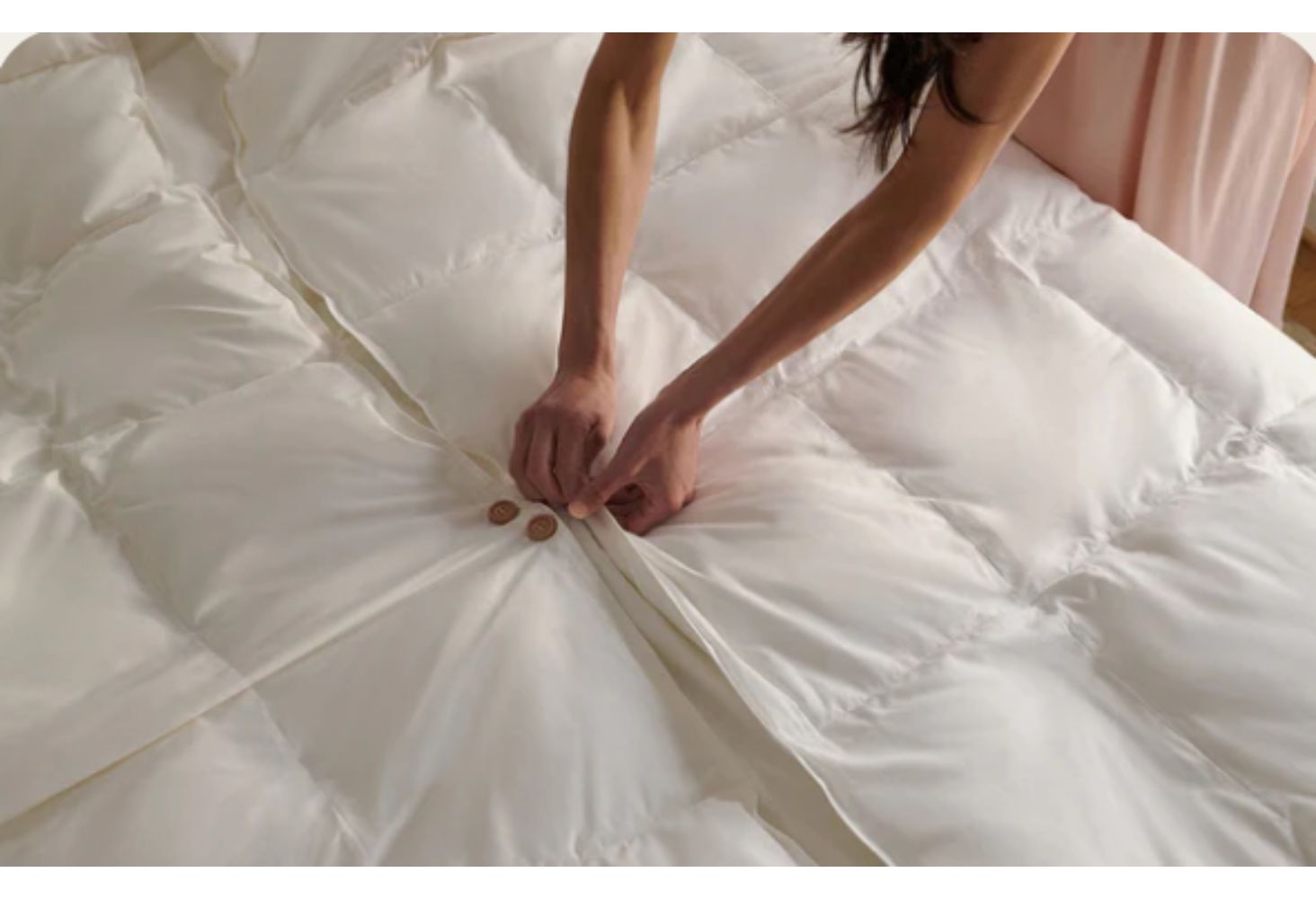
This unique and personalized comforter is perfect for couples with differing temperature needs or to accommodate changing climates comfortably.
Mattress Nerd Score
5.00 / 5
Accessories Details
Material
Cotton, Microfiber
Trial Period
100 nights
Warranty
5-year warranty
Financing
Not Available
The clever design of the Exhale Comforter includes the base comforter and two half panels for adjustable layering on either side. That makes it a great option for personalized warmth all year round. It’s made with an eco-friendly, hypoallergenic microfiber with a soft cotton sateen cover.
What our testers say: “If you sleep with a partner that has different temperature preferences than you, this is the perfect option to accommodate you both!” – Samantha, Editor & Bedding Tester
Best Hypoallergenic Comforter: TEMPUR-Pedic Primaloft Comforter
TEMPUR-Pedic PrimaLoft Comforter
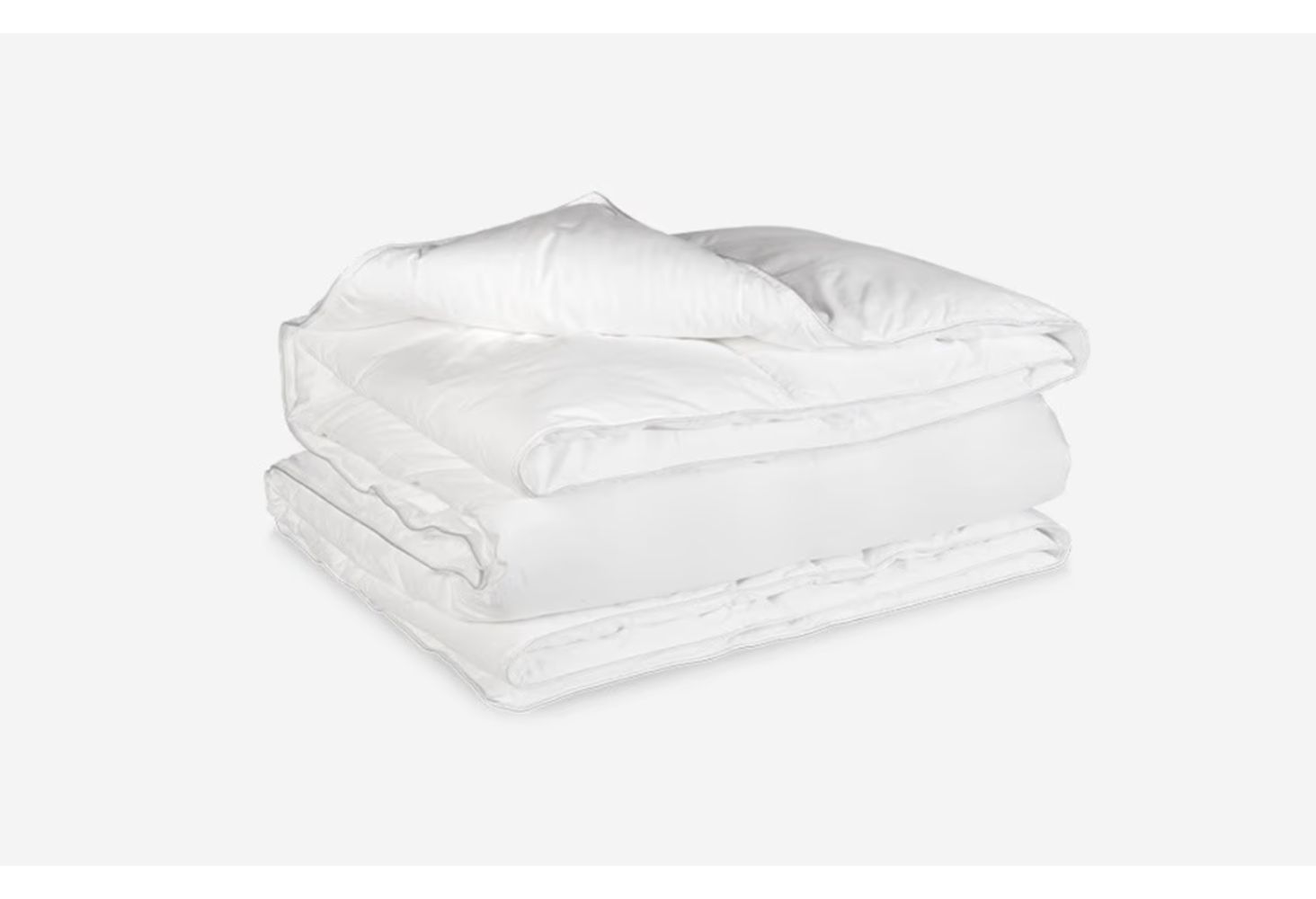
The TEMPUR-Pedic PrimaLoft Comforter is airy, soft, and stays cool throughout the night.
Mattress Nerd Score
4.50 / 5
Accessories Details
Material
Cotton, Down Alternative
Warranty
1-year limited
Financing
Not Available
Return Policy
No returns
The PrimaLoft Comforter is a hypoallergenic alternative to down with a 300-thread count cotton sateen cover. The box quilt design keeps the airy fill evenly distributed for a plush, lofty feel without the heat retention of down.
What our testers say: “The luxurious feel of the PrimaLoft fill makes this option light, airy, and allergy-free.” – Rachael, Bedding Tester
Best Value Comforter: Puffy Deluxe Comforter
Puffy Deluxe Comforter
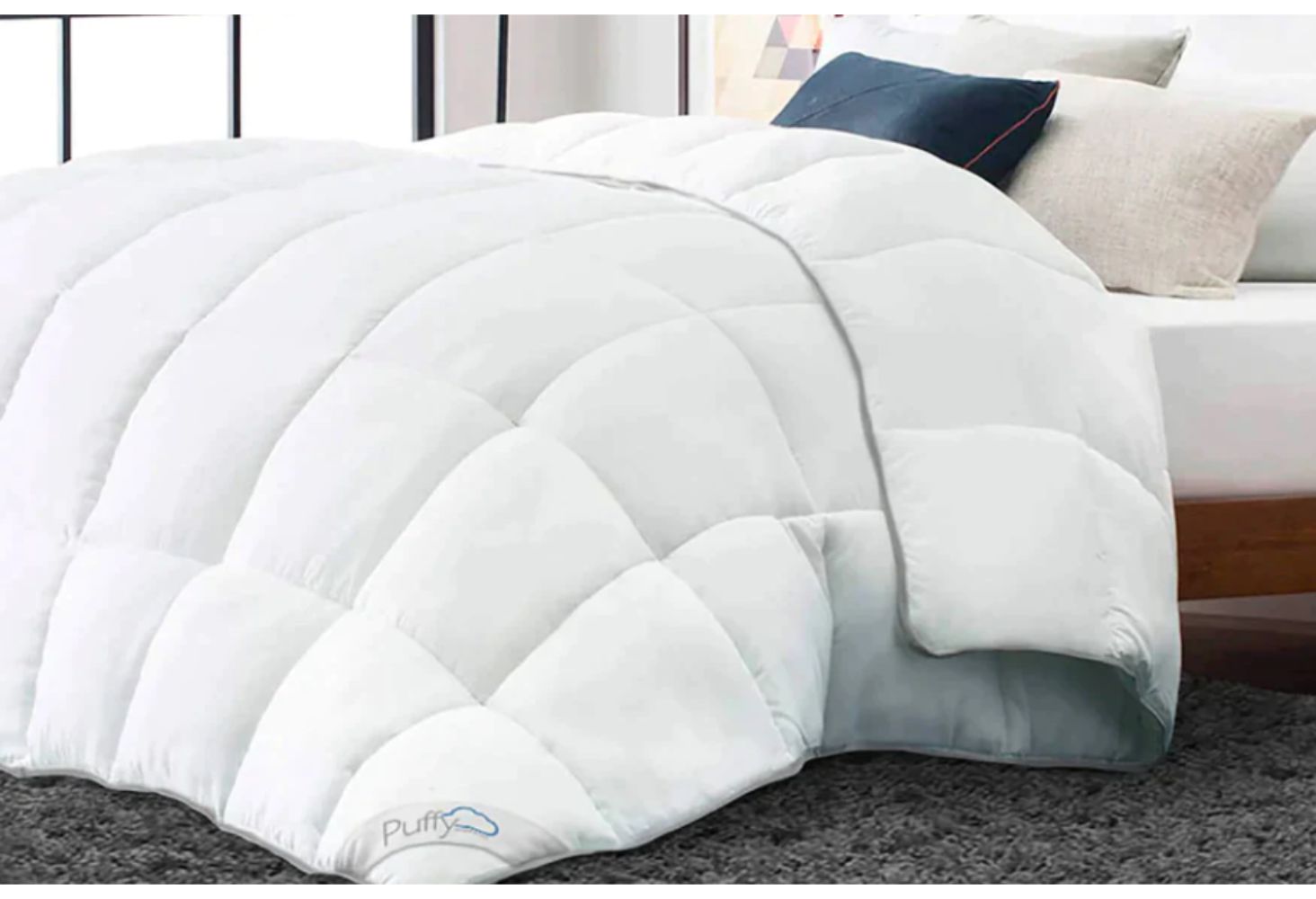
The Puffy Deluxe comforter is hypoallergenic, breathable, and affordable, given its quality!
Mattress Nerd Score
5.00 / 5
Accessories Details
Material
Polyester, Microfiber
Trial Period
101 nights
Warranty
Lifetime Warranty
Financing
Available
Shipping Method
Free shipping
Return Policy
Free returns
The Puffy Deluxe Comforter is a budget-friendly pick made with virgin microfiber fill. That makes it a lightweight, breathable comforter with an all-season design. It’s hypoallergenic and machine washable.
What our testers say: “I found the Puffy Deluxe Comforter to feel very soft and warm, but not hot. It’s nice and lightweight on the body, without a heavy feeling. ” – Becca, Editor & Lead Bedding Tester
Best Weighted Comforter: Brooklinen Weighted Comforter
Brooklinen Weighted Comforter
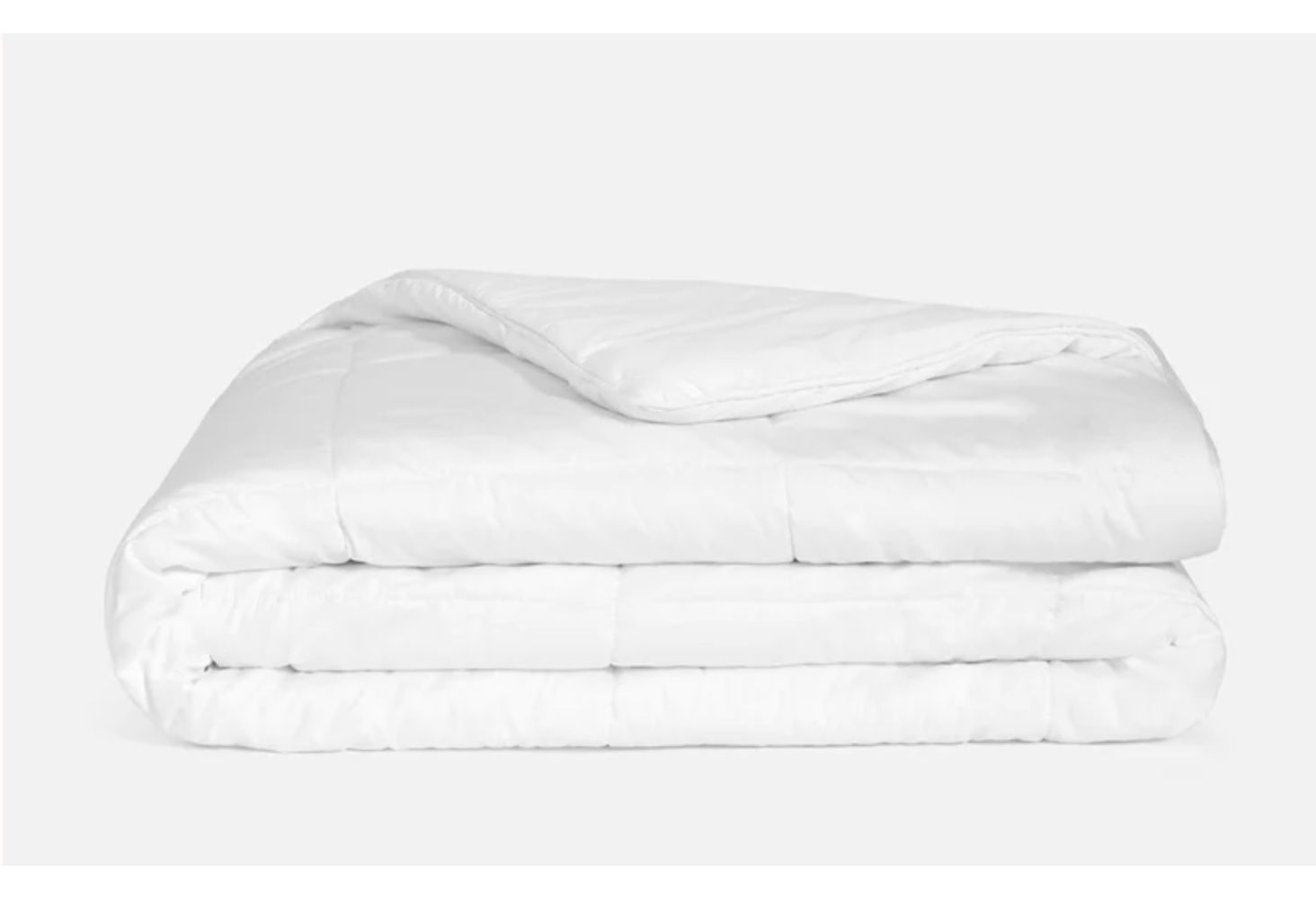
A comforter and weighted blanket in one? Get the calming benefits of a relaxed parasympathetic nervous system with this weighted comforter from Brooklinen.
Mattress Nerd Score
4.40 / 5
Accessories Details
Material
Cotton, Glass beads
Warranty
1-year warranty
Financing
Not Available
Return Policy
Flat-rate return fee
Brooklinen Bedding combined your typical comforter with the benefits of a weighted blanket and put it all into one product— a weighted comforter! Made with a 400 thread-count, 100 percent cotton sateen shell and filled with glass microbeads, this comforter feels heavy, but not constricting. It also stays cool enough to sleep comfortably without overheating.
Weighted blankets are very beneficial for those who have trouble calming down before bed. The light pressure on your chest helps activate the parasympathetic nervous system, which helps to soothe you naturally. As a general rule, choose the weight option that is approximately 10 percent of your bodyweight.
What our testers say: “As a fan of weighted blankets, this two for one product is the perfect value that works all year long.” – Loren, Editor & Bedding Tester
Best Cooling Comforter: Layla Down Alternative Comforter
Layla Down Alternative Comforter
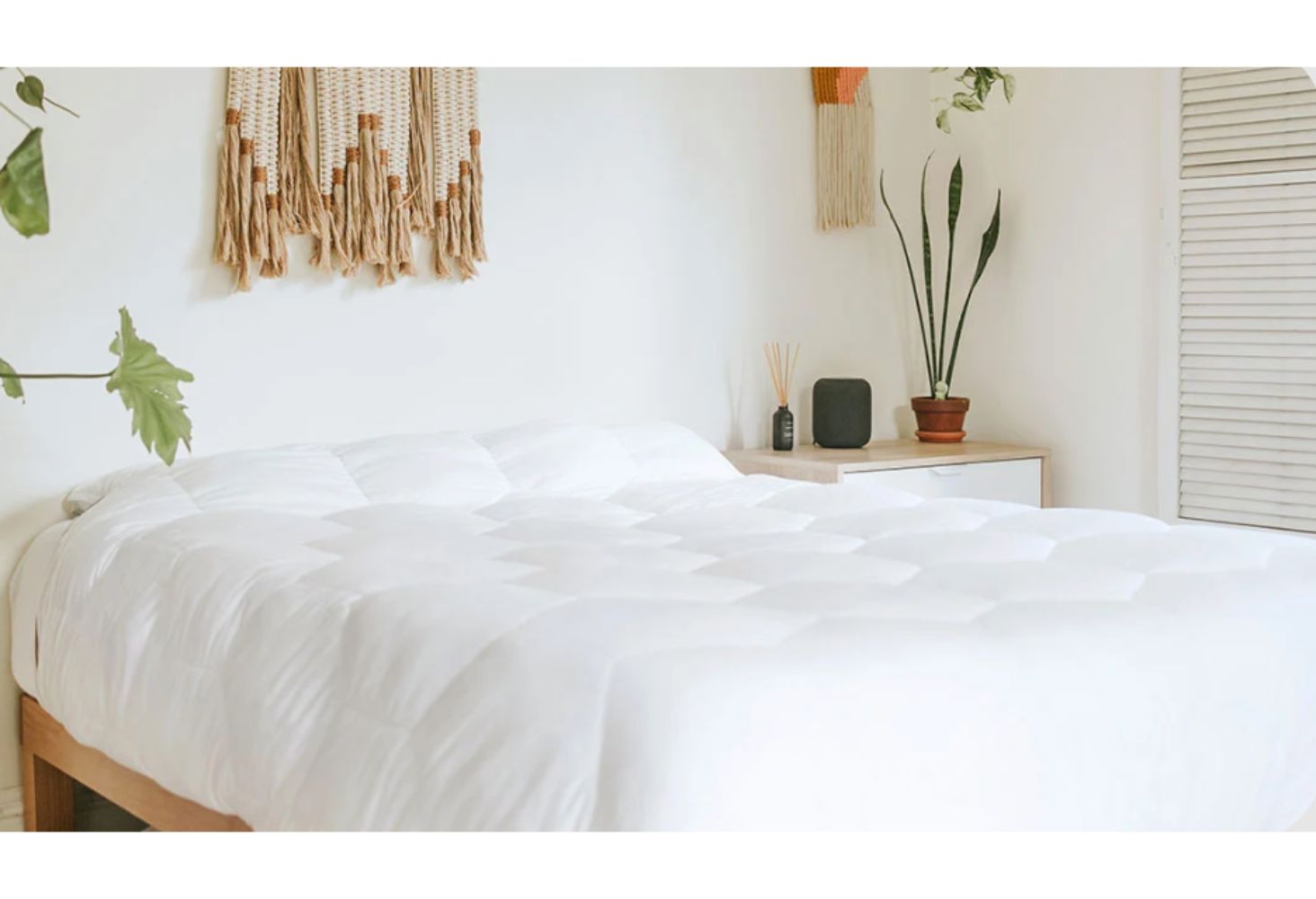
With Layla’s signature honeycomb design, the down alternative comforter is a cooling and light comforter to user year round!
Mattress Nerd Score
4.50 / 5
Accessories Details
Material
Cotton, Down Alternative
Trial Period
30 nights
Warranty
5-year warranty
Financing
Available
Shipping Method
Free shipping
Layla is known for their cooling products, and with this Down Alternative comforter, you get that same guarantee. The fill is a 100% down alternative “cluster loft” wrapped in a 300 thread-count cotton fabric. These materials are temperature-regulating, so you’ll stay warm in the winter and cool in the summer.
What our testers say: “I couldn’t get over how lightweight and breathable this comforter felt. It was also initially cool to the touch when I got underneath, which felt so relaxing before going to sleep.” – Becca, Editor & Lead Bedding Tester
Buying Guide for Comforters
With so many options for comforters, a little consideration is warranted. The right comforter for you is the one made with the kind of materials that meet your specific sleep needs. Maybe that’s extra cozy warmth or cool breathability. Maybe you prefer a light, fluffy feel or something a little weightier. Thinking through your personal preferences can help steer you in the right direction.
Types of Comforters
What goes inside a comforter dictates how it feels. Down and down alternative, like microfiber or polyester, are among the most popular fill materials for comforters. Real down tends to sleep warm with greater insulation, while down alternative materials often sleep cooler. You can also find viscose bamboo, silk, and even wool used in a comforter, all of which offer high temperature-regulating benefits.
Fill or weight is another consideration when you shop. Look for labels that clarify how warm a comforter sleeps. This may range from lightweight to ultra warm.
Comforters are typically categorized by their shell and fill material. Shell materials can include:
- Cotton: Known for softness, this is the most common comforter shell material. It’s breathable and cool and can come in a variety of weaves that either enhance breathability or alter how it feels to the touch.
- Silk: A comforter with a silk shell will have a slight sheen and a soft feel to the touch. While breathable and cool, silk can be troublesome to clean.
- Cotton-Polyester Blends: Blends offer softness with more stretch and breathability than many cotton shells.
- Wool: Wool is soft and warm in winter yet wicks away moisture and perspiration in summer. These are more expensive comforters but are great all-season options.
The fill, or the material found on the interior of the comforter, can include:
- Down: Goose down is soft and very lightweight but bigger and fluffier than duck down. Duck down is smaller but offers warmth and loft, and it’s more affordable.
- Down Alternative: Derived from polyester microfibers, down alternatives offer the same benefits as down with a friendlier price.
- Cotton: Shredded cotton is a fill that’s affordable and offers warmth.
- Silk: Silk, which is best for warm-weather comforters, is light, soft, and thin.
- Wool: Wool is a nice all-season option for fill, providing moisture-wicking in the summer and warmth in the winter. It tends to be more expensive.
What to Look for in a Comforter
There are several important factors to consider when purchasing a comforter, including thread count, construction, care and maintenance requirements, cost, and size.
Thread count refers to the density of yarn per square inch of fabric. Higher thread counts are usually associated with a softer feel, but it’s important to know that manufacturers can inflate the thread count, so a 1,000 thread count isn’t necessarily better than a 400 thread count. For most comforters from a high-quality manufacturer, a thread count of 300 to 500 will be sufficient.
Construction elements of the comforter to consider include shell and fill material, fill power, and stitching style.
Shell and fill material. The most common fill materials include cotton, silk, wool, and cotton blends, and each has its own pros and cons. Cotton is the most common shell material, as it’s known for softness and is breathable. Be sure to research the shell materials prior to purchase. The material inside the comforter is known as the fill, and it can be made from goose or duck down, down alternative, cotton, wool, or silk. The fill will influence the warmth and weight of the end product. Goose down, for example, offers serious warmth year-round, whereas wool provides warmth in the winter and moisture-wicking in the summer.
Fill power is only a consideration for down and down alternative comforters and is defined as how much volume an ounce of down has. The higher the fill power, the more volume, and warmth the comforter can offer. Fill powers range from below 400 to 800+, with 400 having limited warmth and loft and 800 having dense clusters of feathers and the highest level of warmth, durability, and loft available. Generally, the higher the fill power, the more expensive the comforter.
Stitching style: This is important because the stitching style can affect the final product’s ability to keep you warm, its durability, and its quality. Stitching styles include gusseted, sewn-through, baffle stitching, and diamond-quilted. We recommend familiarizing yourself with the pros and cons of each style prior to shopping.
Cost is another important consideration, as comforters can have price points beyond several hundred dollars. A budget comforter will average around $60. You can expect to pay $300 or $400 for a high-end comforter that will last for years.
Best Comforters for Hot Sleepers
Hot sleepers should steer clear of down comforters in favor of those made with breathable and lightweight material. Bamboo viscose, certain down alternative fills, and even silk are naturally temperature neutral, so they won’t retain heat if you tend to overheat at night. Some comforters are made with cooling technology to further cool you down at night by whisking moisture.
Be mindful of the cover fabric, too. Heavier, more insulating fabrics will feel warmer than lighter materials like cotton percale, Tencel, or any material made with bamboo.
Benefits of Comforters
Comforters are designed to add warmth and coziness while you sleep. Because they’re designed with some type of inner fill, they’re a loftier, cozier alternative to a quilt. Typically, a comforter is used on top of a flat sheet, but it can also be layered with other blankets if you’re feeling chilly.
Considerations for Comforters
Here’s what else to keep in mind as you shop for a new comforter:
- Price point. The cost of a comforter is based on the materials with which it’s made. Real down is typically more expensive than down alternative, and you’ll spend more on materials like viscose and silk, too. The popularity of a particularly bedding brand itself can also affect price point. Fortunately, many big brands run frequent sales, so that’s something to keep in mind as you shop.
- Fill power. This is a consideration if you’re shopping for a down comforter. Fill power is an indication of the loft of a down product, and it gives you a good idea of how warm and fluffy it will be. Generally, a fill power of 600 and up is a good choice.
- Trials and returns. Some brands over trial windows and returns, but that’s not always the case. If you’re debating whether a specific type of comforter will suit your needs, it’s never a bad idea to look for brands that offer a trial.
- Care instructions. Some comforters are easily machine washed, while others are spot or dry clean only. It’s really important to be clear about care instructions before making a purchase, so that you don’t inadvertently end up with a comforter that’s too high maintenance for your lifestyle.
How to Clean a Comforter
In general, machine washing and drying aren’t recommended for comforters unless the manufacturer’s tag or website explicitly says that’s okay. Most comforters can be dry cleaned instead. If the comforter is machine-washable, use a delicate setting, mild detergent, and cold water. A front-loading washing machine is preferred, as it will prevent bunching throughout the washing process. Dry on low heat with a few tennis balls for plumping.
Weighted Blankets
A weighted blanket can be a great alternative to a comforter if you’re looking for a potentially anxiety relieving option. If the benefits of weighted blankets are appealing to you, just know that you may be spending a little bit more than you would on a traditional comforter. Check out the Sleep Number True Temp Weighted Blanket to learn about one of our favorite options.
FAQs about Comforters
What is a comforter?
A comforter is similar to a thick blanket that goes on the top of your bed for warmth. It’s different from a blanket in that comforters often have multiple layers with a fluffy fill inside.
What’s the difference between a comforter and a duvet?
The big difference between a comforter and duvet is that a duvet is typically used as an insert with a cover. Comforters can generally be used as-is without the need for a cover.
How can you tell if a comforter is good quality?
High-quality materials tend to be a good indication of quality. Shopping from reputable brands can also help ensure you’re buying a high-quality comforter.
How long should you keep a comforter?
It really depends on the materials and the craftsmanship of a particular comfort. However, since comforters don’t have to bear the weight of you and your partner the way mattresses do, they tend to last much longer. You can reasonably expect at least 10 years, and often much longer, out of high-quality comforters.
| Comforter | Award |
| Brooklinen Down Comforter | Nerd’s Pick |
| Luxome ClimaSense Comforter | Best Cotton Comforter |
| Saatva All-Year Down Alternative Comforter | Best Down Alternative |
| Cozy Earth Silk Comforter | Best Luxury Comforter |
| Coop Sleep Goods Exhale Comforter | Best Adjustable Comforter |
| TEMPUR-Pedic Primaloft Comforter | Best Hypoallergenic Comforter |
| Puffy Deluxe Comforter | Best Value Comforter |
| Brooklinen Weighted Comforter | Best Weighted Comforter |
| Layla Down Alternative Comforter | Best Cooling Comforter |
